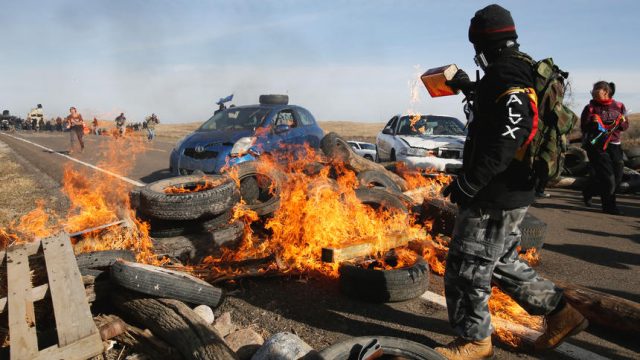What if the Fort Laramie Treaty Actually Required Standing Rock to Accept the Dakota Access Pipeline?

A protestor pours gasoline on a fire blocking North Dakota Hwy. 1806 on Thursday, Oct. 27, 2016, north of Cannon Ball. Michael Vosburg / Forum Photo Editor
There has been a lot of talk of late about treaties from the protesters trying to block the Dakota Access Pipeline, with the assertion that the land the pipeline is being built on is land the Sioux people never ceded to the federal government.
“Today, the Oceti Sakowin has enacted eminent domain on DAPL lands, claiming 1851 treaty rights. This is unceded land,” Mekasi Camp-Horinek, the organizer of illegal camps on Highway 1806 and a portion of the private-owned Cannonball Ranch, said Sunday in a news release. These are the camps law enforcement cleared out yesterday as the, ahem, “peaceful” protesters met them with thrown rocks and fire.
Whether or not the land in question is truly unceded land is a question for the courts, not something we must take as gospel when screamed at us by a bunch of angry political extremists. As it stands today the land is private and the Dakota Access Pipeline folks the proper easements to work there.
But it may be a moot point. Even if the land did belong to the tribe, a SAB reader pointed out to me this morning that the Fort Laramie Treaty of 1868 seems to say that the tribe must accept the pipeline:
The Ft. Laramie Treaty of 1868 appears to require the tribes to accept the Dakota Access Pipeline. @robport #DAPL https://t.co/7JPdVGNleq pic.twitter.com/VrQUBAv0qj
— Matt Thompson (@dakotapastor) October 28, 2016
Here’s a link to the treaty from which that text is quoted on the Standing Rock tribe’s own website.
Per the tribe’s history page, they take the text of this treaty seriously. “The Standing Rock Sioux Tribe stands by its right to self-government as a sovereign nation, which includes taking a government-to-government stance with the states and federal government entities,” their website states. “Having signed treaties as equals with the United States Government in 1851 and in 1868, which established the original boundaries of the Great Sioux Nation. The tribe staunchly asserts these treaty rights to remain steadfast and just as applicable today as on the day they were made.”
It’s worth reiterating that no part of the Dakota Access Pipeline is on the Standing Rock Indian Reservation as those boundaries are recognized today. So when the tribe and the environmental extremists they’ve made common cause with claim that the pipeline is on “treaty land” I don’t think they have a case. And that means the Fort Laramie Treaty really isn’t all that relevant here.
But even if it was, it seems like the path forward for the pipeline would be clear under a clear reading of the text of the treaty. The tribe must accept “works of utility” as long as they’re paid a sort of easement.
Which definitely would have happened if the Dakota Access Pipeline crossed Standing Rock tribal land. After all, the Dakota Access folks paid an easement to the Three Affiliated Tribes of the Fort Berthold Reservation where the pipeline does cross tribal lands.
That tribe approved the pipeline on a 5-0 vote with two abstentions. A reader from that area sent me a (unfortunately low-quality) photo of the minutes which seem to have disappeared from the tribe’s website.

UPDATE: A reader points out that the Three Affiliated Tribes resolution approving the DAPL easement is available in a web archived version of the tribe’s website. It doesn’t appear as though the minutes in the screenshot above were ever posted.
Anyway, I’ve downloaded a PDF copy of the resolution from the archive which you can read below. I’ll keep it online in case the archive disappears too. The pertinent section begins on Page 22.
[scribd id=329252410 key=key-6xtKfV8ND224VbD2GFhA mode=scroll]




